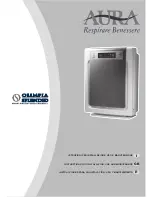
Engine Maintenance
90
Changing the Antifreeze
1. Run the engine until it is up to operating
temperature. Stop the unit.
2. Open the drain cock and completely drain
coolant. Observe coolant color. If the coolant
is dirty, proceed with a, b, and c. Otherwise go
to step 3.
a. Run clear water into radiator and allow it
to drain out of the drain cock until it is
clear.
b. Close the drain cock and install a
commercially available radiator and block
flushing agent, and operate the unit in
accordance with instructions of the
flushing agent manufacturer.
c. Open the drain cock to drain water and
flushing solution.
3. Run clear water into the radiator, and allow it
to drain out of the drain cock until it is clear.
When water has finished draining, close drain
cock.
4. Inspect all the hoses for deterioration and the
hose clamp tightness. Replace if necessary.
5. Loosen the water pump belt. Check the water
pump bearing for looseness.
6. Inspect the radiator cap. Replace the cap if the
gasket shows any signs of deterioration.
7. Mix one gallon of the appropriate permanent
type antifreeze concentrate and one gallon
clean water in a container to make a 50/50
mixture. (Do not add antifreeze and then add
water to the unit. This procedure may not give
a true 50/50 mixture because the exact cooling
system capacity may not always be known).
8. Refill the radiator with the 50/50 mixture.
Bleeding Air from the Cooling
System for Units with Coolant
Expansion Tank Only (Ending 10/16)
Often when a self powered truck unit cooling
system is refilled, air is trapped in the engine
block and/or under the thermostat. To effectively
remove all air from the cooling system we
recommend using the Vacuum Fill Procedure (see
below) or the Spill Free Funnel Procedure (see
page 92).
NOTE: If an engine runs with air trapped in the
block, the engine may be damaged. The high
water temperature switch may not protect an
engine that has air trapped in the block, because
the high water temperature switch is designed to
protect an engine from overheating due to
failures in the cooling system and the loss of
coolant.
Vacuum Fill Procedure
1. Remove the expansion tank cap (P/N 13-990)
from the pressurized side of the expansion
tank.
CAUTION: Avoid direct contact with hot
coolant.
CAUTION: Avoid direct contact with hot
coolant.
CAUTION: Do not remove expansion
tank cap or open the system when coolant
is hot.
CAUTION: Do not start the engine
without bleeding the air out of the block.
1.
Overflow Tank Cap
2.
Expansion Tank Cap
Figure 164: Expansion Tank
2
1
Содержание T-1080S
Страница 102: ...Engine Maintenance 101 Figure 182 Fuel and Oil System Components ...
Страница 182: ...Index 181 Unit Options 23 W wiring 79 wiring diagrams index 182 ...
Страница 184: ...183 Schematic Diagram Page 1 of 2 RELEASED 06 Jul 2015 13 52 47 GMT 7 ...
Страница 185: ...184 Schematic Diagram Page 2 of 2 RELEASED 06 Jul 2015 13 52 47 GMT 7 ...
Страница 186: ...185 Wiring Diagram Page 1 of 5 ...
Страница 187: ...186 Wiring Diagram Page 2 of 5 RELEASED 06 Jul 2015 13 52 47 GMT ...
Страница 188: ...187 Wiring Diagram Page 3 of 5 ...
Страница 189: ...188 Wiring Diagram Page 4 of 5 RELEASED 06 Jul 2015 13 52 47 GMT ...
Страница 190: ...189 Wiring Diagram Page 5 of 5 ...
















































